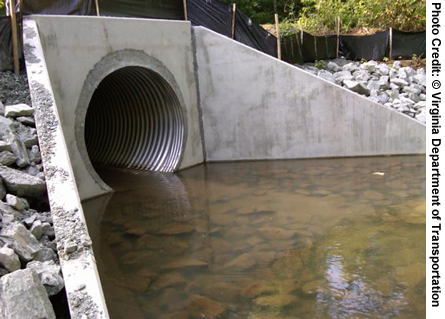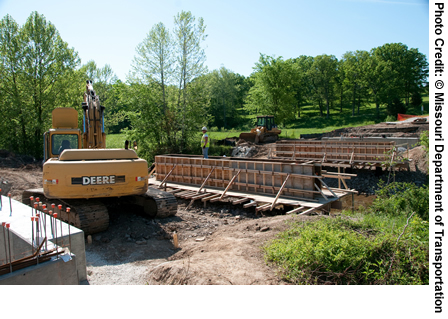U.S. Department of Transportation
Federal Highway Administration
1200 New Jersey Avenue, SE
Washington, DC 20590
202-366-4000
Focus
| Accelerating Infrastructure Innovations |
Publication Number: FHWA-HRT-10-014
Date: June 2010

Think design-build. Now think big. In Missouri and Virginia, hundreds of bridges are being rehabilitated or replaced more rapidly and efficiently through the use of bundled design-build contracts. Launched in 2009, the Missouri Department of Transportation's (MoDOT) Safe and Sound Bridge Improvement Program includes a $487 million design-build contract that will replace 554 bridges located in 111 of the State's 114 counties by the end of 2013. In Virginia, meanwhile, the Virginia Department of Transportation (VDOT) is replacing 119 bridges and culverts over the next 2 years using seven design-build contracts that bundle projects geographically and by type of work. The contracts range in size from $6 million to $12 million for bridge projects and $2 million to $5 million for culvert projects. VDOT received funding for the bridge and culvert replacements under the American Recovery and Reinvestment Act of 2009 (ARRA).
"We are always interested in improving our structural inventory and coming up with a contract that works. We have been using design-build for several years now and after careful consideration decided it was one of the tools that would work best for these projects," says Shailendra Patel, Assistant Director of VDOT's Innovative Project Delivery Division. "Design-build helped us build efficiencies into the contracts and move more quickly."
With the design-build project delivery process, a project owner executes a single contract for both architectural/engineering services and construction. The design-builder may be a single firm, a consortium or joint venture, or other organization. Design-build can promote innovation, streamline coordination between the design and construction teams, reduce project costs, and result in time savings. Approximately 45 States currently have full or limited statutory authority to use the design-build project delivery method.
In anticipation of the ARRA funding, VDOT's design-build initiative progressed rapidly, with discussions beginning in December 2008 regarding the best way to improve the State's inventory of structurally or functionally deficient bridges and structures on secondary roads. Requests for proposals were then developed over the next 3 months and the contracts were advertised in April 2009. In contrast, if VDOT had advertised the 119 structures individually using traditional design-bid-build contract delivery, the process could have taken several years. The bundling of structures also made the contract value large enough to attract bridge contractors who might not have bid on a small individual project.
To ensure that contractors bid on exactly the same scope of work, VDOT investigated each project site and developed a descriptive scope of work. "We had to be very specific in the scope sheet and define what we wanted and how the risk for the project was assigned," says Patel. The criteria for selecting structures for the design-build contracts included that a structure had to be structurally deficient or functionally obsolete on the verge of becoming structurally deficient. Superstructure and deck replacement projects were allowed but no total bridge replacements. Candidate structures needed to have substructures in good condition, though substructure work could include patching and crack repairs. Low volume roads were preferable. Structures also needed to be low risk in terms of design, with no bridges over railroads or navigable waterways, for example.
Construction work has now begun on the Virginia bridge and culvert replacements, with many of them expected to be completed this year.
"This is a method that could be replicated nationwide," says Rodolfo Maruri of FHWA's Virginia Division Office. "When you look at the bridge inventory across the country, many of the bridges that are structurally deficient are smaller bridges on lower volume roads. Using design-build contracting in Virginia has enabled the design and construction work to be done faster and more economically, resulting in better performing bridges."
"By packaging the projects together in several contracts, it reduces construction management and project management costs, creating efficiencies for both the contractor and VDOT," adds Tom Jennings of FHWA's Virginia Division Office.
The use of design-build has also spurred innovation. For example, a Virginia contractor's recommendation to use precast concrete elements for a superstructure replacement reduced the construction time for one bridge project from 45 days to 15 days, saving $15,000 and resulting in less inconvenience to the local community.

The Virginia Department of Transportation replaced a culvert on Route 627
over Armistead Creek in Halifax County, VA, as part of its design-build initiative.
In Missouri, the $700 million Safe and Sound Bridge Improvement Program has two phases. In the first phase, 248 bridges are being rehabilitated through a modified design-bid-build contracting process, where the bridges are being put out to bid in groups according to their location, type, and size to expedite the design and construction process. More than 100 of those bridges were completed in 2009. From April through November 2009, MoDOT was reopening a new bridge every day and a half. The second design-build phase of the project kicked off in May 2009 with the awarding of a $487 million contract to KTU Constructors to replace 554 bridges. Costs are higher for the design-build phase but the work has been accelerated. KTU, a joint venture of Kiewit Western Company, Traylor Brothers, Inc., and United Contractors, Inc., has committed to completing construction by December 31, 2013.
The key goals of the Safe and Sound program are to deliver good bridges at great value, minimize public inconvenience through increased construction speed and a flexible schedule, and to complete construction by December 31, 2013. Missouri selected 802 bridges for the program from its list of more than 1,000 structures in the State that are in either poor or serious condition. "This innovative approach, which includes design-build contracting methods, provides for significant system improvement in a short time. Our average duration for bridge replacement under this program is targeted at 45 days, less than half the time we've historically taken to complete these types of projects," says Ken Warbritton of MoDOT. "This gets the projects completed quickly and reduces the inconvenience to the traveling public."
KTU began work on four bridges in the fall of 2009, with 160 bridges scheduled for construction in 2010. A "progress meter" on MoDOT's Safe and Sound project Web site at www.modot.org/safeandsound monitors how many bridges are under construction and how many have been completed. As of June 11, 2010, 152 bridges had been completed and 45 were under construction.
The four initial design-build bridges constructed in 2009 allowed the contractor to better assess how to do the work faster, more efficiently, and more cost effectively, providing a system verification test of the process. These four bridges were completed in an average of less than 35 days each, with the fastest completed in 22 days. This compares to more traditional methods where 90 to 110 days are often typical for small bridge replacements. "Design-build allows the contractor to bring innovation and a different way of thinking to a project," says Ken Foster of FHWA's Missouri Division Office.
This innovation was reflected in a recently completed bridge on Route 61 over Buckeye Creek in Cape Girardeau County. The previous pony truss structure was replaced with two Super-Cor® structures, which are prefabricated metal culverts with concrete retaining walls. Using the prefabricated components allowed the bridge to be completed more quickly and required less labor.
To learn more about MoDOT's Safe and Sound Bridge Improvement Program, contact Ken Warbritton at MoDOT, 573-526-3282 (email: kenyon.warbritton@modot.mo.gov), or visit www2.modot.org/safeandsound/index.htm. For more information about VDOT's design-build bridge improvement projects, contact Shailendra Patel at VDOT, 804-692-0476 (email: shailendra.patel@vdot.virginia.gov). Information on VDOT's design-build program is available at www.virginiadot.org/business/design-build.asp. VDOT currently has 18 active design-build contracts that are valued at approximately $264 million and anticipates advertising additional design-build contracts valued at $380 million over the next several years. For information on design-build project delivery, visit www.fhwa.dot.gov/construction/cqit/desbuild.cfm, or contact Jerry Yakowenko at FHWA, 202-366-1562 (email: gerald.yakowenko@fhwa.dot.gov).

This bridge over Spring Creek in Cole County, MO, was replaced under the Missouri
Department of Transportation's Safe and Sound Bridge Improvement Program.
The bridge reopened to traffic 5 days early after a 45-day closure.